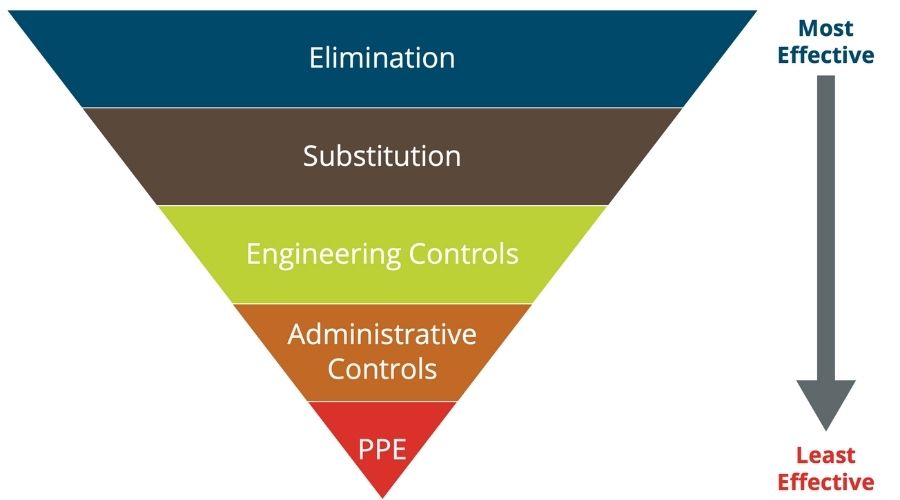Control Risk in Your Gym The Right Way

Many climbing gyms inform customers that “climbing is inherently dangerous” or that “climbing gyms cannot eliminate risk.” Although true, there are ways to reduce risk and when reducing risk, some methods are better than others.
“All wall owners, operators, employees, clients, participants, or others using or accessing a climbing wall facility must understand that climbing, whether indoors in a climbing facility, or outside, is a technical sport involving inherent and other risks, hazards and danger that can lead to damage to equipment or property and injury, or death,” informs the most recent iteration of the CWA’s Industry Practices standards.
The hierarchy of hazard controls seen below is a method of thinking that helps leaders across industries identify if they are putting the right control in place, with a clear “first to worst”. Below, we will examine these Hierarchies of Control and how they can be applied to the indoor climbing world.

To put these five controls into easy-to-understand scenarios for industry professionals, here is how the hierarchy of controls might be applied to various scenarios, primarily focusing on a topic that most climbers know all too well: falling
1. PPE (Personal Protective Equipment)
PPE or Personal Protective Equipment is a common term and strategy for injury prevention across industries. In the climbing world, we see it in harnesses, helmets, gloves and more. When climbing on a rope or auto belay, PPE is already in use and required for utilizing a facility, such as a properly fitted harness, and any required belaying device.
PPE is at the bottom of the hierarchy because it does not reduce the likelihood of risk, it simply adds a layer of protection for if/when a mishap or fall occurs.
2. Administrative Controls
Administrative controls include a wide variety of items, often focused around pre/post task checklists or education. Items such as orientation, belay classes/checks and signage reminding folks of proper behaviors (“Are You Clipped In?”). Less obvious examples of administrative controls include emails to the staff/community and word-of-mouth communication.
Administrative controls are one step up the hierarchy because they move from acceptance of risk (PPE) into the prevention of risk. Administrative controls’ effectiveness is limited due to the number of users required to follow procedures to make them effective. The human element is the crux, and the next steps move into truer prevention.
3. Engineering Controls
Engineering controls attempt to create barriers between the user and the hazard. You can think of engineering controls as “dummy proofing” the process, so it is harder to make mistakes.
Potentially the most common engineering control is the process of performing a partner check prior to climbing. Another example is auto belay barriers covering one or more start holds, preventing a climber from beginning the route without clipping in.
Each of these examples make it unlikely or hopefully impossible for one or more mistakes to be made by a climber.
4. Substitution
The second most advantageous option for hazard elimination is substitution. In substitution, a more hazardous situation is eliminated in favor of something less hazardous. An example in roped climbing are assisted braking devices replacing tubular belay devices (or vice versa depending on which camp you are in!). Another is utilizing locking carabiners on top-roped routes instead of expecting participants to tie in themselves. This creates fewer chances for user error but also increases the burden on the facility to maintain more PPE.
Behind the scenes, routesetters constantly perform substitution controls, often during forerunning. Setters eliminate or adjust higher-risk moves to balance the intent/purpose of the move with the risk incurred by the participant.
In each of the examples above you can see that substitution can be challenging because the elimination of one risk may create another. However, the goal is always that the overall level of control increases with all controls in combination.
5. Elimination
The final, most effective, control is elimination. Completely removing the risk from the environment. This is almost always the most desirable outcome but can be burdensome to the facility or the participant. Specifically, in climbing, the best option is often substitution, due to the acceptance of inherent risk and hazards in all manners of climbing.
Elimination in roped climbing may include a policy that there are not certain types of climbing techniques, such as dynos, below a certain height, or at all. Revisiting the setter substitution example above, if a climbing sequence cannot be effectively substituted, sometimes the solution is to eliminate that sequence and start over.
Elimination of a hazard can be built in, such as wall design that does or does not include certain combinations of features, to prevent risk. This may include combinations such as steep overhanging walls over slab in bouldering.
In most cases, a single control will not be sufficient for proper risk mitigation within a facility. Instead, controls are combined to create the best balance of business demands while reducing risk. Auto belay stations benefit from a combination of controls:
- PPE – harnesses secure climbers to the auto belay device.
- Administrative – orientation teaches procedure and signage states to clip in before climbing
- Engineering – auto belay barriers help prevent climbing without first clipping in
- Substitution – locking carabiners replace traditional carabiners
In the end, climbing always has inherent risk, even after implementing controls at all levels. It can be beneficial for leaders to educate themselves and their staff on the types of controls available. It is the sum of these controls, including the CWA’s Industry Practices and facility procedures, which will allow participants to maximize their climbing experience.
Interested in helping mitigate risk at your gym? Check out the 2022 CWA Summit's Legal and Risk Management sessions and register today!
About the Author
 Paul Terbrueggen, aka Tall Paul, is an operations leader with 10+ years of experience between Amazon Fulfillment where he led teams of 25-4500 and Summit Climbing, Yoga & Fitness where he served as the Retail Director and then Chief Operating Officer for their eight locations in Dallas/Fort Worth, Texas where he currently resides. An avid boulderer, he can often be heard claiming to be "more tall than talented" at 6'6". Paul enjoys all manner of activities, indoor or outdoor, especially when shared with his girlfriend Becky and two puppies Penny Lane and Lil McGill (but everyone knows her as Nancy).
Paul Terbrueggen, aka Tall Paul, is an operations leader with 10+ years of experience between Amazon Fulfillment where he led teams of 25-4500 and Summit Climbing, Yoga & Fitness where he served as the Retail Director and then Chief Operating Officer for their eight locations in Dallas/Fort Worth, Texas where he currently resides. An avid boulderer, he can often be heard claiming to be "more tall than talented" at 6'6". Paul enjoys all manner of activities, indoor or outdoor, especially when shared with his girlfriend Becky and two puppies Penny Lane and Lil McGill (but everyone knows her as Nancy).
